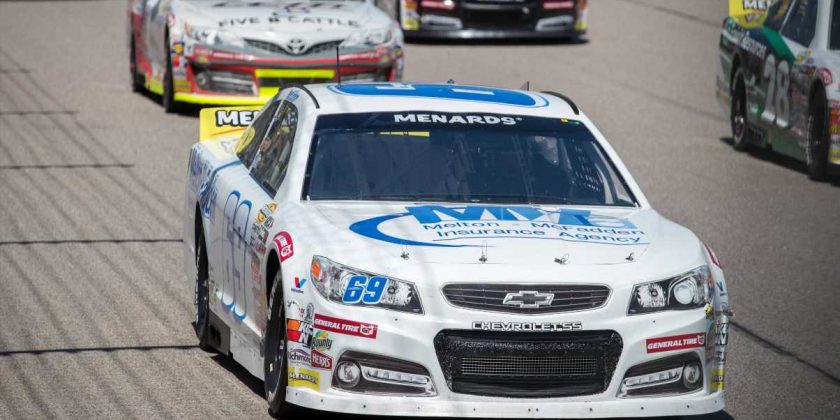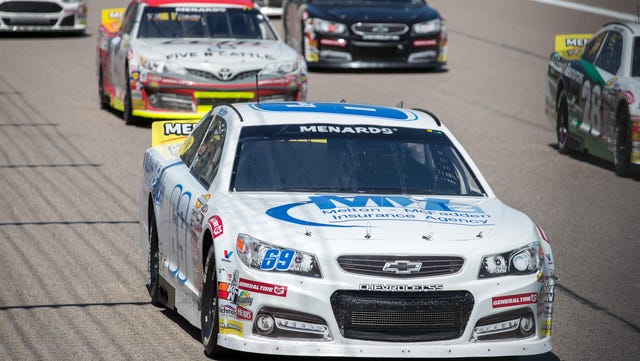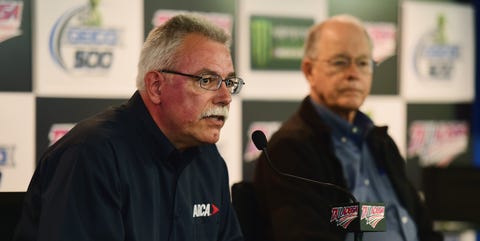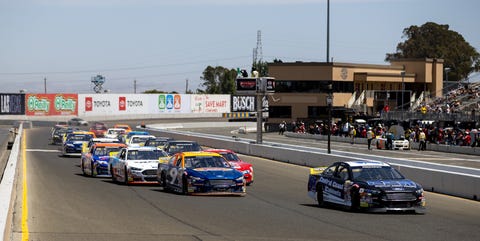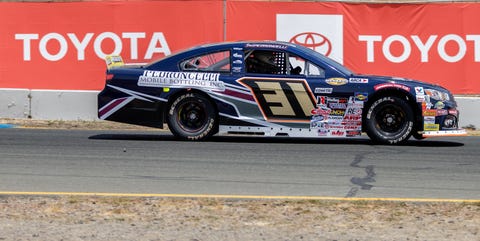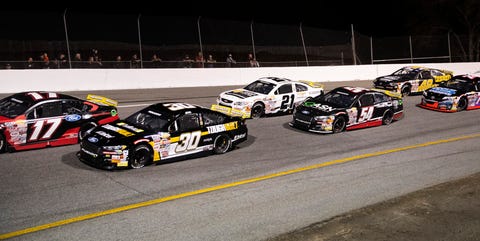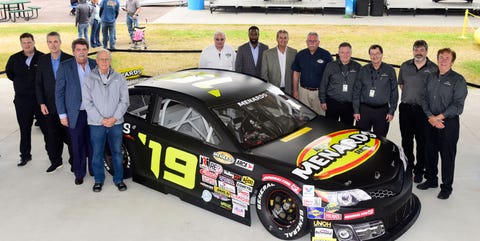From Dayton to Daytona, the ARCA Racing Series has continually evolved to fit within a racing ecosystem always much larger than itself over the past seven decades but reaching 1,500 races is effectively an inflection point.
This is not the ARCA that series president Ron Drager inherited in 1996, but that sanctioning body wouldn’t have been recognizable to his grandparents, ARCA founders John and Mildred Marcum either.
ARCA has always existed as a driver development platform while also serving as a de facto track day club and that spirit remains true today — three years after its official acquisition by NASCAR.
Despite the merger and ARCA’s integration into the former K&N Pro Series East and West divisions, the sanctioning body is still operated by Drager out of an unassuming office located in Toledo, Ohio, just as it has been for most of its existence.
Drager now has a larger role in NASCAR’s overall decision-making process, a seat at the figurative table as it were, and conviction that his family legacy will continue in some fashion over the decades to come.
“We have been encouraged to continue operating in the ways we always have,” Drager said. “In fact, we were encouraged to employ our business practices with East and West and operate those as closely as we could.
“But the biggest difference is that we’re no longer hesitant to ask NASCAR for help. It felt like we were stealing a base when we asked for help. ARCA is now part of a much bigger motorsports world.”
Drager compared ARCA to a ‘little rowboat in the middle of the ocean,’ susceptible to getting rocked by the waves of changing tides, and the 2018 sale was about ‘getting on a much bigger boat’ to withstand that tide.
The timing proved fortuitous too, as Drager isn’t sure what would have become of ARCA during the pandemic year without NASCAR’s infrastructure around it.
“I’m not saying we wouldn’t have survived, but I am saying for certain that we would have lost a great deal,” Drager added.
The ARCA Racing Series rule book has always been an interesting read because it exists purely on the existence of trickle-down Cup Series and Xfinity Series technology. It’s where journeyman racers and development prospects could get their hands on affordable hand-me-down cars and race at some of the most iconic venues in the country.
Walking around the ARCA Series garage on any given race weekend will reveal old Cup Series and Busch Series cars, custom chassis built for ARCA and K&N over the years, and various technologies developed for Cup.
With the imminent arrival of NASCAR’s Next Gen car in 2022, and its radical shift from everything that came before it, ARCA will soon have a considerable amount of trickle-down equipment to implement should it so choose.
There are no shortage of options on the table for ARCA and NASCAR.
“There are some high-quality, safe chassis that are really the framework for what’s currently on the racetrack now in Cup, so how can our ARCA platform best take advantage of that,” Drager asked, rhetorically. “We know there are a fair amount of those chassis that will go directly into the Xfinity Series, but we also know there are a lot that won’t.
“So, we’ve been working strategically with NASCAR to try to make sure that we don’t miss an opportunity to acquire reasonably economically viable race cars for our teams.
“When I say that, I’m saying for the same price or less that you can buy a Late Model roller chassis, therefore making the entry point a little more manageable for teams and maybe change parts of our business model where you might need to pay a David Gilliland, Joe Gibbs or Billy Venturini to race … to one where teams can buy their own stuff and race as often as they want.”
THE COST ISN’T THE CAR
On paper, what Drager is suggesting seems reasonable and thematically similar to the ARCA entry list booms of the late 2000s when the introduction of the Car of Tomorrow led to an infusion of trickle-down Gen-4 Cup Series chassis.
The rules were so similar back then that Bill Davis Racing famously entered Scott Wimmer into an ARCA race at Atlanta Motor Speedway that got rained out, so they entered the Cup race with that same car instead — leading nine laps and finishing 22nd with it.
But veteran racer and tenured megateam owner Billy Venturini is hesitant to endorse this long-term strategy. In fact, he believes a further integration of the outgoing Cup Series chassis doesn’t address the problems, because the current car isn’t the primary barrier to entry.
There are no shortage of competitive cars available in shops across the country or available from Venturini himself.
“I’ll say this right now, car counts are not down because of the vehicles,” Venturini said. “They keep saying that we have to find ways to make it cheaper to get people in the cars, but the cars are not the cost. The operating expenses are the cost.
“So, the problem is that the decision makers have come in, and they look at expenses line-by-line, and circle ones they say are too big, and address them.”
That’s why ARCA eliminated live pit stops and replaced them with several field freezing breaks instead, but Venturini says the operating costs really haven’t changed that much.
“By time you get to the bottom line, and that’s all I care about as a team owner, we didn’t change the bottom line too much,” Venturini said. “We just changed how we spent our money and lessened our product in the process.”
All these changes were made in the hopes of keeping teams around that ended up leaving the series anyway.
Chad Bryant Racing closed when its eponymous team owner joined GMS Racing. Ken Schrader Racing and MDM Motorsports both closed after the merger. Mason Mitchell Motorsports won a championship and closed down too.
Tommy Praytor operated an ARCA team for a decade alongside son Thomas with a stated goal of being the best of the rest.
ARCA has traditionally featured three categories — the championship caliber cars, the mid-pack family teams and the start-and-park drivers. The Praytors always strived to lead that middle tier. Now 31, the younger Praytor only races once a year, nearest to home at Talladega.
NASCAR’s version of the ARCA Racing Series hasn’t been accommodating to Praytor and his contemporaries and that’s why most of them are gone.
It began with the introduction of the Ilmor 396 engine and ARCA’s efforts to get every team on that platform, and thus, off the legacy ‘built’ engines that had been hallmark of the series for years. To do so, ARCA ordered the legacy engines severely detuned, rendering them so ineffective that it would further encourage teams to make the transition.
It started from 9,000 rpms to 8,000 and then to 7,000.
During a race at Madison International Speedway in Wisconsin in 2015, a group of these family teams still on the legacy engine program met with Drager to encourage the sanctioning body to restore their engine power output to more competitive levels.
That group included Praytor, Wayne Hixson, Darrell Basham, Wayne Peterson and James Hylton, and they were unable to convince ARCA to give them back a little more power because the sanctioning body needed to ensure Ilmor was the clear-cut engine of choice.
Of course, since the K&N Pro Series merger, ARCA has actually given the legacy engines more power, but it was too little, too late.
“They called us to tell us they gave us our stuff back, but we already sold it,” Praytor said. “The worst thing you can do is to give a racer a reason to go do something else, because he won’t ever come back.”
It’s an old adage in racing that a racer is a racer until they buy their first boat.
“That’s absolutely right.”
Praytor says the cost to purchase an Ilmor is now over $40,000 and $20,000 to get it rebuilt, and they can only be built and sealed by the company itself. Willie Mullins Racing has three Ilmor engines currently and they told Autoweek that two need rebuilding at costs of $25,000 and $30,000 each.
They both said they could go Truck Series racing for that kind of money and get more return on investment, too.
NASCAR underestimated the family teams’ ability to get their legacy engines purchased and rebuilt for far cheaper than what Ilmor offered.
A legacy engine could be purchased for around $12,000 and rebuilt for $7,000 or less.
Basham rebuilt engines himself, while Praytor had a local business near his home in Mobile, Alabama service their engines after consulting with the series and OEM for how to go about it. The family mid-pack teams often cut sponsorship or under-the-table deals to get engines rebuilt for even cheaper.
Whatever it took to get to the race track.
“Although we are pro Ilmor and composite body, it’s almost impossible to get into ARCA without some money now,” Dinah Mullins said. “10 years ago, you could pick up that cheap Cup chassis, and old cut off body, a used Cup motor and go racing.
“That’s how we broke in, but we couldn’t get in the door the same way we did in 2008.”
When NASCAR took over the finances for ARCA, teams started getting paid via electronic wire transfers and not after the race at the payout booth or team trailer as had been the case for decades. While that might work for the likes of Venturini and Gibbs, teams with an operating budget, that didn’t work for the mid-pack family teams.
“I was counting on that $3,000 to get out of here, and they started telling us it will be deposited two weeks from now,” Praytor recalled. “Mon and pop teams needed that money that night if there was a race the next week.”
And while it would be easy to tell these family teams to do a better job of operating a race team, many of them are no longer there.
A team like Praytor used to go to the annual winter test at Daytona International Speedway and was only required to pay a flat entry fee for the car and driver. The Praytors would use that test to bring a couple of dozen crew members or potential sponsors.
“That weekend was like a business sign that said ‘we’re open for business’ and they shut it down,” Praytor said.
The thinking was that if Praytor could just get some potential sponsors in the infield for the test, get them access to Frank Kimmel, Phil Parsons and the broadcast team already on-site doing research, he could convince them to come back to sponsor the team in front of 10,000 fans in February.
NASCAR then began mandating that anyone given access into the infield during the test needed to have a license.
So much for that business opportunity each winter.
The nickel and diming didn’t stop there. Even as NASCAR abolished live pit stops, they still required anyone who went over the wall to have a full fire suit and helmet at $350 a crew member for cars that are parked and shut off.
“What the hell is the point of that, and now I’m out another $2,000,” Praytor added.
Then came the rule that all gas containers for generators needed to be metal and not plastic, another $250.
All of this is to say the cost isn’t the car, because there are at least a hundred cars of various competitive qualities sitting in shops across the country that could make it to the track this weekend, but there are other more pressing barriers to entry than the racing platform.
WHAT ABOUT THE CAR?
Venturini says ARCA’s rule book is already too convoluted before trying to make room for an additional spec of car and the uncertainty about what could or wouldn’t be permitted or banned is a barrier for entry.
“One of the reasons we struggle with cars right now is if you look through our rule book, we have two different chassis we could run, and last year it was three, we have three different type of motors we can run and each one has a lead, aluminum or steel box you have to run with it,” Venturini said. “There’s weight breaks, so about 20 different weight combinations in which we can weight. There’s two different windshields we can use.
“Everything is combined into a total weight, and there’s a lot of different formulas that go into what your car is supposed to weigh. …
“You shouldn’t have to be worried about all these other variables and that uncertainty is why people aren’t there. Like, (they don’t know) if they have the right chassis for the future and what about the motor or windshield and what that means for your weight or weight breaks. I’ll be honest with you, it’s kind of insane because it’s like trying to combine three different late models in one race and giving them their own rules.”
That’s from a team owner who is likely to be here no matter what, and who wishes there was just a simplified rule book featuring spec parts across the board and more certainty over what the rules would be from year to year.
Praytor responded to this sentiment by saying ‘get over it,’ but then offered a more reasoned explanation for the take.
“Honestly though, we did the one car and one motor thing for a couple of years, or at least tried to get there,” Praytor said. “How did that work out for you?”
The you, of course, being ARCA itself.
The expansive rule book was basically come one, come all, and a spec platform is simply too expensive for family teams to continue participating — especially on short tracks.
OUTLAWS UNDER ARREST
Potentially a much larger issue moving forward is that ARCA is objectively no longer cool.
“We were kind of an outlaw series,” Venturini said. “Our rules were looser, our tracks were different and we were kind of the wild wild west of racing. I hate to say it, because no one has advocated for this series more than I have, but we have become a bland cookie cutter series.”
With the intent of saving teams money, races are now cut into segments with controlled pit stops that no longer require professional over the wall crews at best or training school students at worst. The cars are serviced by the traveling team under an allotted period of time and they drive off pit road the way they came down it.
To better reflect the other national tours, ARCA also places a restrictor plate on its various engine packages to run with reduced power, big downforce and a considerable amount of drag.
Regardless of what the rules package looks like, Venturini says ARCA needs to address the show or the series might not survive the decade.
Why?
“Lack of interest, lack of interest man,” Venturini said. “Everything we’ve done has made the product less attractive. People will spend the money if it’s cool. When it’s not, they won’t as much. I just feel like, look, the low horsepower has created terrible racing.
“I’ve never seen less passing on the race track than you do now. The lack of pit stops has made the races a glorified practice session. It’s just not a good product. I’m sorry to say that, I hate to say it because no one has been a bigger advocate of the series than I have. I’m not completely proud of where this thing is going.”
The schedule increasingly features more Cup or Xfinity companion races and less signature short tracks. One Salem race has been replaced by Bristol. Winchester is back, but Indianapolis Raceway Park is not. Fairgrounds Speedway Nashville is now an ARCA East race.
“I’m not going to say ARCA isn’t cool anymore,” Praytor said, “but anything that’s really cool about ARCA comes from the family teams and there’s far less of them now than ever before. Without the family teams, it’s just another NASCAR series and there’s already three of those.”
THE BRIGHT SPOT
By Drager’s own admission, ARCA is primarily a de facto minor league, and a platform for young drivers to develop their crafts before moving to a national touring level.
“The ARCA series is a career destination for professional racers and a developmental series for those who aspire to race at higher levels,” he said. “For the folks like Frank Kimmel, the Venturini family and Andy Hillenburg, they’re happy to carve out a living racing here. Not everyone passes through, but we are best known for that development aspect.”
Right now, there are now Frank Kimmel archetypes in ARCA — that successful short tracker turned national series mainstay.
Drager aspires to bring that back.
“Our role is to be a friendly platform for grassroots racers to transition into a series where you can race at Daytona International Speedway,” Drager said.
That goal is currently best represented by Greg Van Alst, a 40-year-old Super Late Model champion who returned to ARCA this season for the first time since 2002. When Van Alst captured the 2019 Champion Racing Association championship — that prize included a test at Daytona the next winter.
The experience was so enthralling that he purchased a car from Chad Bryant and has contended for wins throughout his part-time season.
“I really wouldn’t mind being the veteran face old guy of ARCA,” Van Alst said. “That would be awesome, but it always comes back to money. If we lost our sponsor today, I’d be able to carry us for the rest of the season, but that’s it.
“I don’t want to say it’s borderline too expensive because the reason I looked at doing ARCA is because when we were running the Bristol Super Late Model race, the Winchester 400 or Redbud 400, those bigger races, and you compare what it costs to contend in those races to ARCA and you’re almost spending the same.
“I spent less going to Daytona in February than I spent going to the Winchester 400 — 45 minutes away from my house.”
Van Alst says teams are only allowed four sets of tires for the race weekend at Pocono, and that compares to unlimited set for marquee Super Late Model races, ‘so why wouldn’t I want to race on TV the same weekend NASCA is there?’
That’s definitely a point on the board for the ARCA model.
“I’m going to race some of the tracks I never thought I would get to race on so if it’s costing me the same, why not,” Van Alst said. “Now, I’m not going to lie. We’re spending more now than I anticipated, but only because I didn’t anticipate running this well at the start.
“So, it’s kind of like, if we’re going to be a 15th place team, I was spending the same amount as my Late Model. We’re a fourth to eight place team so we’re going all out now. I’m getting good tires to practice on.
“We’re not using someone used tires to practice on. We’re doing what we did when we won the Late Model championship. We’re mocking up in practice. We’re trying to get everything we can out of the race car because we’re running up front, and that entices you to do more than when you’re running with a 15th place car.”
For Van Alst, the decision to run ARCA comes back to Daytona, something no other stock car racing platform outside of NASCAR can offer.
The test he earned after winning his CRA championship changed his entire perspective.
“If we lost our sponsor today, and it came down to running Daytona or running a full short track or Late Model schedule, I’m picking Daytona,” Van Alst said. “If I could only run one race a year, I’m picking Daytona. There’s nothing like going through that tunnel and racing in front of that crowd during Speedweeks.”
Van Alst isn’t alone, of course, as he is joined by veteran Tour Type Modified racer Andy Jankowiac or Super Cup Stock Car Series mainstay Jason Kitzmiller.
It’s just a matter of making the series more viable for them to commit to a more robust schedule.
OPTIMISM PERSISTS
All told, while those within the ARCA sphere might quibble over rule packages or entry lists, everyone agrees that Ron Drager is the right man to continue steering this ship under NASCAR’s leadership.
“If NASCAR just lets Ron run ARCA, it will be the best version of ARCA it can be,” Praytor said. “Let it be a family-run organization, for mostly family-run teams, in front of families in the grandstands.”
It’s a position Drager never even expected to be in.
“I wasn’t going to do this,” Drager said. “I went off to Ferris State College and got a degree in marketing and a minor in journalism. I wanted to be Matt Weaver.
“The way things worked out, grandmother needed help and I wanted to help. I’ve worked at a race track as long as I can remember, cleaning up trash from under the grandstands, stubbing tickets and selling programs.
“I thought maybe there could be more to life than working at a race track and I was going to figure it out. But ARCA kept calling me and that never happened. I don’t regret a minute of it. I’m a believer in fate and that everything happened for a reason.”
So even under the larger NASCAR umbrella, the ARCA garage is grateful for Drager and his continued presence, but he’s equally appreciative to anyone who has ever participated in ARCA, attended ARCA or covered the races.
That first ARCA race took place on May 13, 1953 at Daytona Raceway.
“There are thousands of racecar drivers, owners, sponsors, hundreds of promoters and so many people who have been supportive of ARCA since then,” Drager said. “Crew members who were loyal to the brand and willing to make those sacrifices to get us to the next race, the next season. I’m most proud of all the quality people in our garage.”
That passion, support, debate and optimism intends to persist for another 1,500 races too.
Source: Read Full Article
